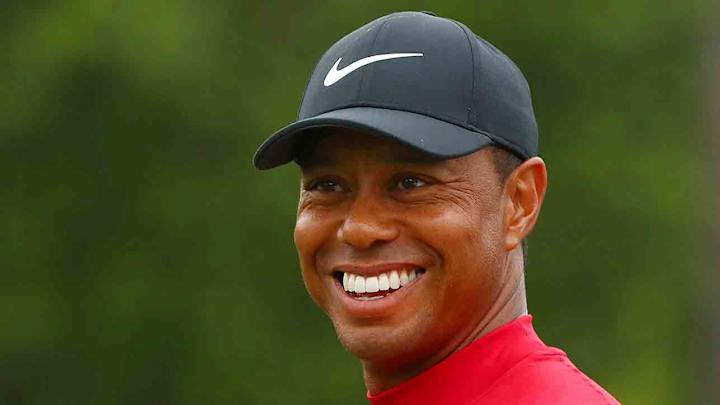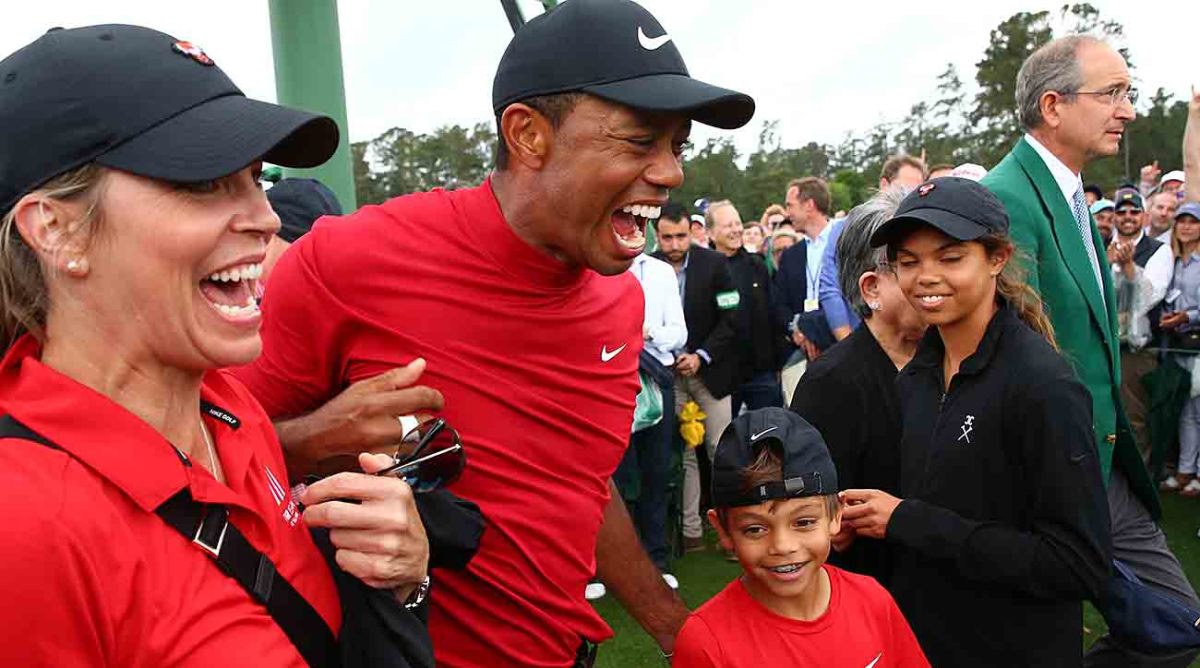From Family Hugs to Commercial Hits, Here Are Some of Tiger Woods's Greatest TV Moments

After 26 ½ years, 82 PGA Tour victories and several trips to hell and back, Tiger Woods has never been more beloved—a daft assertion considering the tonnage of fame he attained during his dominance. To think of an aging, physically damaged, competitively compromised Tiger as being more popular than the cold-blooded, mentally superior gladiator who ruled golf throughout the 2000s qualifies as something of a marketing miracle.
Something nobody could have possibly foreseen. Something quite extraordinary.
When the 20-year-old prodigy signed a $40 million endorsement deal with Nike in the summer of 1996, Woods instantly became far wealthier as a media creation than as an aspiring tour pro. He would demolish the hype faster and more convincingly than any athlete before or since, but the custodians of Woods’ public image continued to play a huge role in transforming the gifted young athlete into a cultural phenomenon.
They were rather successful, at least for a while. Nike released a string of television ads that remain the most creative and memorable commercials the game has ever seen. Woods became the most powerful pitchman in golf history, possessing a reach deep into pockets of society that even Arnold Palmer couldn’t match. Thanks to shrewd management and Tiger’s own reluctance to take on business endeavors that might interfere with his pursuit of immortality, he risked overexposure only by virtue of winning so frequently.
Those days are long gone, but as we saw again last week in Los Angeles, Woods’ presence in the field at any tournament remains one of pro golf’s most precious assets. His willingness to continue competing at age 47 with whatever he has left is driven almost solely by his love of the game and the challenge it presents. This trait might best explain Tiger’s growing appeal to the masses since returning from spinal fusion surgery in 2018.
With that long-winded background as a compass, here is one observer’s compilation of Tiger’s most impactful TV moments—a collection of on- and off-course snapshots that have shaped public perception of Woods’ remarkable career and jagged relationship with fame. Through shameful scandal, personal fallibility and bodily harm, no athlete has made more people forgive and forget than the Dude in the Red Shirt. Here are eight reasons why.
> Last Sunday marked the 13-year anniversary of the confession heard ’round the world: Woods’s eagerly anticipated admission to dozens of extramarital affairs, which led to his divorce from Elin Nordegren. It was an awkward announcement made in the form of a televised press conference; Tiger read from a prepared statement in a halting voice more than 2 ½ months after the halo had crashed to the floor. The damage to his image was irreparable, or so it seemed. No man can redeem himself until a stack of adversity blows up in his hands.
> Nike produced a lot of great promotional spots featuring Woods in the early stages of their partnership. There was Frank, the talking head cover who busted Tiger’s chops at the barber shop and the diner. The “Hello World” campaign that caused a ruckus with its political tenor right after Eldrick turned pro, plus a few that included Rory McIlroy, but none grabbed viewers more effectively than the “hacky sack” commercial. Thirty seconds of Woods juggling a golf ball with a wedge, switching hands and bouncing it between his legs, then bringing it to rest on the clubface before swatting it into the sky with one hand. God bless YouTube.
> Never has the humanization of Tiger been more apparent than in the moments immediately following his two-shot victory at the 2006 British Open. Upon holing out on Royal Liverpool’s 18th green to claim his 11th major title, a sobbing Woods collapsed in the arms of caddie Steve Williams, succumbing to the pent-up grief lingering from the death of his father Earl two months earlier. Since when did crying become a sign of emotional weakness?
> Earl’s son experienced his first brush with fame on the "Mike Douglas Show” when he was 2 years old—the little fella trotted onto the set with a bagful of clubs over his shoulder and a golf swing only the big fella upstairs could account for. Three years later, Eldrick was the subject of a five-minute feature on ABC’s “That’s Incredible,” which included tournament footage of a multi-ethnic kindergartner holing 10-footers for par against men 10 times his age. To think that same guy left so many putts short last week at Riviera ...
> As a clever sequel to the hacky sack ad, Nike released a spot in which Woods breaks a window on three different levels of an old warehouse in consecutive swings. According to urban legend, an entire morning was set aside for Tiger to execute his assignment. By 9 a.m., the shoot was a wrap.
> Those who view Woods’ triumph at the 2019 Masters as the exclamation point on the greatest comeback in golf history are casualties of modern hyperbole, but that’s not to say his 15th major title wasn’t an accomplishment of remarkable proportions. People tend to forget how well Tiger played throughout 2018, a season that ended with his winning the Tour Championship. Or that he received a ton of help from the four final-round contenders who found Rae's Creek at the par-3 12th. Or that Ben Hogan won six majors in the five years after a head-on collision with a Greyhound bus.
With all that in mind, the sight of Tiger hugging his son Charlie after claiming a fifth Masters produced a portrait of perpetual relevance. Greatness may not last forever, but in the eyes of Father Time, it remains nothing less than permanent.

> HBO’s 2021 documentary “Tiger,” a visual derivative to the Jeff Benedict/Armen Keteyian biography released three years earlier, was panned by many critics for emphasizing the negatives in Woods personal life. His 2017 arrest for driving under the influence received considerable attention in the second half of the miniseries. Reality is as reality does, however, and it’s worth noting that “Tiger” debuted just a month before his near-fatal single-car crash outside Los Angeles. The police-cam footage and mugshot that emerged from the DUI provided disturbing reminders of the dangerous scenarios that can accompany horrible judgment. Woods may be immune to pressure, but lapses in logic are a different story.
> He won the 2000 U.S. Open by a wider margin and authored an irresistible storyline at the 2019 Masters, but it was Woods’s performance at Augusta National 22 years earlier that shook the world—a four-day overhaul of the competitive landscape that ushered the PGA Tour deep into the mainstream of America’s viewing conscience. Tiger’s first major title remains his most profound accomplishment—a staggering precursor to the unfathomable dominance that would begin a few years later. Many of today’s best players cite the ‘97 Masters as the motivating source behind their own careers, which lured better athletes to a game in which its guiding force remains its most durable and dependable commodity.
That’s no marketing miracle. Just bald-faced reality.
